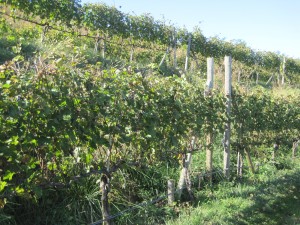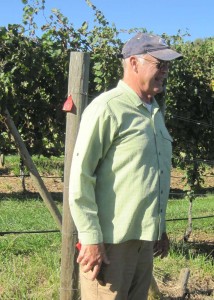Finding the Perfect Spot to Plant Vines
It’s hard to imagine anything more important to the establishment of a great vineyard than the selection of the right piece of land, yet hardly any step gets less attention from home vintners. That’s because most of us use the land we already have. And even those of us who search for a property with a vineyard in mind sometimes give less than full attention to the site’s suitability for growing wine grapes.

- Slopes are good for vineyards, but this is almost too much. Try getting your tractor across it without tipping.
I can attest to that. Before buying our Nelson County home, we looked at something on the order of 45 properties. Initially we set our parameters at five acres or more, preferably 10. We excluded properties that were wooded (“private” in real-estate speak), and those that were at too low an elevation to provide safety from winter freezes. We wanted slope, we wanted an eastern aspect, we wanted land that was so infertile that a farmer would turn his nose up at it. (Bad soil is ideal for wine grape production, but that’s a story for another post.)
And in the end, we bought a property that was only three acres, with a western aspect and tall trees on the eastern border that would limit sunlight in the morning. So what in the name of all that’s holy were we thinking?
Well, this is the home we plan to retire to in a few years, and we pretty much just fell in love with it. It’s a great house with beautiful mountain views. And it does have a few things going for it as a vineyard property: slope (almost too much slope), really crappy soil, good drainage, and a small section at the western end that we believe will get sufficient sunlight for grape production.
So, with the choice of land already made, you might wonder why we enrolled in a class on site selection at Piedmont Virginia Community College. Nothing like locking the barn door after the horse is out, right? Or maybe this is more like opening the door to get the horse after the race is over. Something like that.
We took the class, in large part, because it was the last one we needed for our certificate on Viticulture. (Yes, we will graduate!) At the back of our minds, we thought there was at least a possibility that we might find

- Chris Hill, one of Virginia’s most noted vineyard consultants, talking about site selection at Del Fosse Vineyards, Faber, Virginia.
ourselves searching in a year or two for another small parcel that would be used exclusively as a vineyard. But one major reason we took the class is because it was taught by Chris Hill, one of Virginia’s best-known vineyard consultants. Trust me: tell almost anyone involved in commercial wine-grape production in Virginia that you are thinking of starting a vineyard and they will almost certainly suggest that you contact Chris Hill. Many of the best vineyards in the Commonwealth have retained his services.
Well, as it turned out, the class was almost as useful to us now as it would have been prior to the purchase of our little plot of land. Almost, that is. I still wish things had worked out so that we had the benefit of this class before we started our search. But we learned a lot in this class that will help us as we lay out the vineyard, and that more than justified the time and cost of the class.
For example, the southern slope of a property gets the most sun and will be several degrees warmer throughout the day, so grapes will ripen best in that area. We knew that. But what I hadn’t thought of until Chris discussed it is that you can use that knowledge to decide which varietals to plant in different parts of the vineyard. Some clones ripen earlier than others. So if you have lots of land, some with a southern aspect, some with a northern aspect, you’ll want to plant the late-ripening vines on the southern slope.
And if you have only a little bit of land, as we do, you can still take advantage of the characteristics of each bit of it. The coldest part of a property is at the bottom of a hill, since the heavier cold air will always push down the slope. (And if there is a creek nearby, it will be especially cold.) Consequently, you’ll want to plant vines that ripen early at the bottom of the slope. (Of course, if you have enough land, you may not use that area at all.)
If you had the perfect property, you would lay out the vineyard so that the vines ran laterally across the slope, rather than up and down the slope, and in a north-south direction. That’s the ideal. But there are exceptions. If the slope is too steep for a tractor to operate safely, you may want to run the vines up and down the hill, no matter what the orientation is, and try to compensate. As I said earlier, you work with what you have.
Chris has been in this business for a good 30 years, and it’s amazing what he’s learned. Among the tidbits he offered was a suggestion that we check meteorological records to get an idea of what to expect in terms of temperatures throughout the season. We had thought about that. But here’s what we didn’t think about: you should look at record temperatures, not averages. As Chris noted, the winter temperatures can average several degrees above or below freezing throughout the winter, but still dip well into the sub-zero area every once in a while. The averages are great, but the extremes can kill you.
Or rather, they can kill the vines. At some point below zero-degrees Fahrenheit, the vines are likely to die. (Negative eight is often cited as a break point.) And if that happens, you might find that you’ve lost the vineyard you’ve patiently nurtured over the years to the point where you are just starting to get enough fruit to make wine.
But we’ve chosen our property. We’ll be planting vines there, laying out the vineyard the best way possible, and praying for good weather. Or, at least, an absence of really bad weather, particularly killing freezes. And who knows? A little bit of prayer couldn’t hurt, could it?
Category: All Posts, Virginia Wineries, Viticulture



Comments (1)
Trackback URL | Comments RSS Feed
Sites That Link to this Post